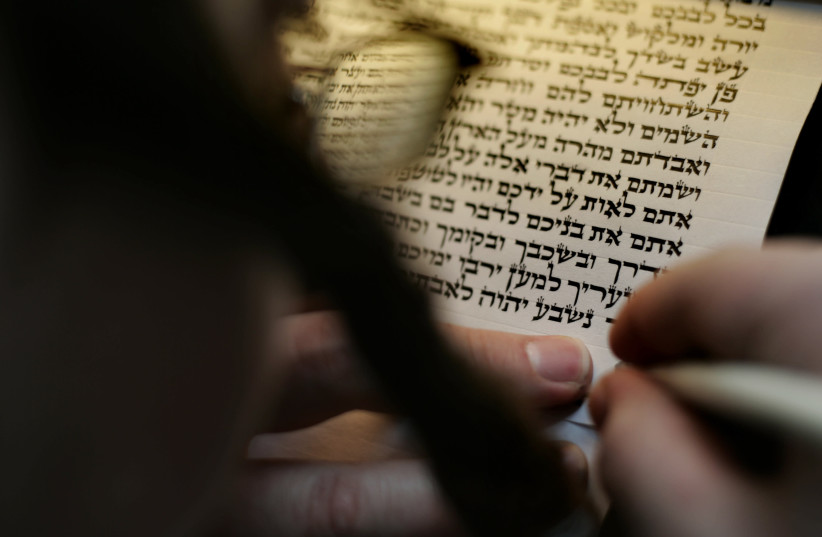One of my earliest memories is of reciting the Shema each Sunday morning in heder. Although I didn’t come from a religious family – we were more your traditional three-times-a-year shul-goers – and I didn’t go to a Jewish school, I could recite the Shema word for word from a very young age.
At some point, probably when I stopped going to heder after my bat mitzvah, I stopped saying it. Since then, it’s lain dormant in the dark recesses of my mind.
That is, until a few days ago, when I was on my way home from work. We (my husband collected me from the train station) stopped at a set of traffic lights by a huge advertising billboard that bore a picture of a heavily tattooed, kippah-wearing man covering his eyes with his right hand, deep in prayer.
The words “Shema Yisrael, Hashem Elokeinu, Hashem Ehad” were written in large Hebrew letters across the top.
I felt drawn to this larger-than-life, extraordinary image on a number of levels. Not only was it fascinating, as tattoos and religious imagery don’t generally go together, but I also felt something in me stir when I read the words.

Shema Yisrael, Hashem Elokeinu, Hashem Ehad; Hear O Israel, the Lord is our God, the Lord is one.
I took a photo, which I later posted on Facebook without commentary. Surprisingly, the post generated a myriad of responses. Some, like me, were fascinated by the image, whereas others found it uncomfortable or offensive, even calling it “religious coercion.”
I later learned that the man in the picture was none other than former Big Brother contestant Ben Wiernik, who also appeared in a video in which he shares some fascinating stories about the Shema and its role in Jewish history.
He tells of how this prayer has often been used to discover the presence of Jews where all other methods have failed.
Discovering the presence of Jews with the Shema
On October 7, for example, the Shema played an important role: “‘Shema Yisrael,’ shouted the soldiers to the survivors who were hiding in the bunker, in order to recognize them as Jews and not the enemy in disguise.”
Wiernik also goes on to explain how the chief rabbi of Israel, Rabbi Dr. Yitzhak Herzog, grandfather of President Isaac Herzog, saved over 500 children after the Holocaust. Thousands of Jewish parents sent their children to monasteries to save them, but after the war ended, there was no one to collect them. The heads of the monasteries and even the pope denied they had Jewish children living there, but Herzog didn’t give up on his mission to save these Jewish orphans.
With only a few minutes in each monastery, it was almost impossible for him to ascertain which of the thousands of children were Jewish. Faced with this problem, before he left he shouted “Shema Yisrael, Hashem Elokeinu, Hashem Ehad.”
“Then an amazing thing happened,” Wiernik says. “Seven little hands rose up on their own to cover their eyes. The rabbi shouted ‘These are Jewish children. Their mothers taught them to say Shema Yisrael before they put them to bed every night.’”
These fascinating stories symbolize for me and doubtless many others, the power of this prayer. It’s a universal prayer recognized by Jews across the globe regardless of their age, sex, background (Sephardi, Ashkenazi, or Mizrachi), or level of observance.
Indeed, as the Shema plays such an integral role in the lives of most Jews, whether consciously or unconsciously, one synagogue in Australia uses it to boost security by asking newcomers to recite the prayer before going inside. “Security without the muscle!” as someone described it.
With everything that’s going on right now in Israel, seeing the opening words of the Shema above a picture of someone reciting the prayer brought some comfort to me – as doubtless it did to many Israelis – when we least expected it.
For me, those words signify the unity of the Jewish People, binding us together through thick and thin. They are as important now as they were 70 years ago, after the Holocaust, and again just a few months ago, on October 7. Sadly, my memory appears to have failed me, as I couldn’t bring to mind all of the words that I’d last uttered some 40 years ago. However, just placing my right hand over my eyes and reciting the first few lines of the Shema brought a comforting blanket of reassurance. In that moment, I felt connected to my home, my country, and my people.
In the words of Wiernik: “To say Shema Yisrael does not mean you are religious; it means you are Jewish, that you are a crucial part, that you belong. No matter what you’re going through or where you are, in any situation, you can always put your right hand over your eyes and say, ‘Shema Yisrael.’”
The writer is a former lawyer from Manchester, England. She now lives in Israel where she works at The Jerusalem Post.
